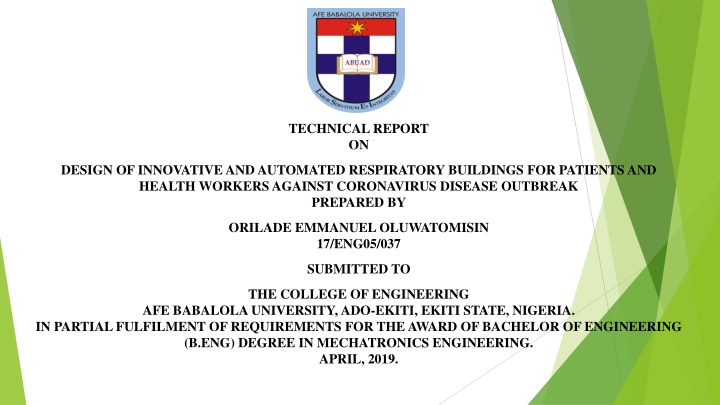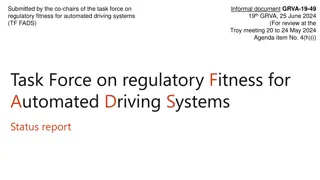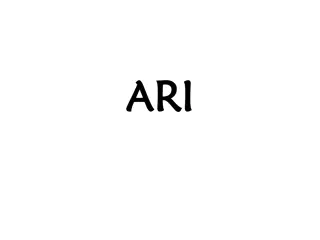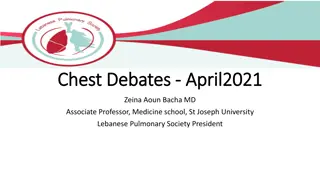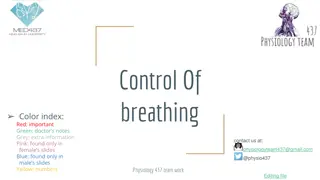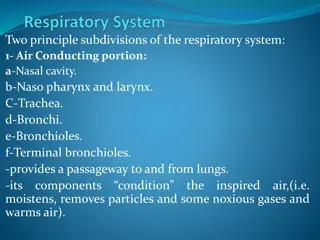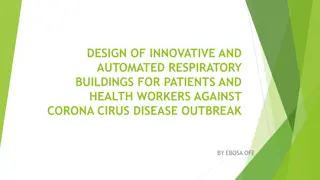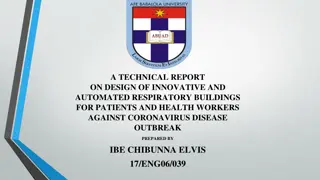Design of Innovative Automated Respiratory Buildings Against Coronavirus Disease
This technical report discusses the design of automated respiratory buildings to aid patients and health workers during the coronavirus disease outbreak. It explains the concept of respiration, the purpose of these systems, and the construction process. The aim is to ensure precise oxygen delivery and carbon dioxide removal for individuals with respiratory complications.
Download Presentation

Please find below an Image/Link to download the presentation.
The content on the website is provided AS IS for your information and personal use only. It may not be sold, licensed, or shared on other websites without obtaining consent from the author.If you encounter any issues during the download, it is possible that the publisher has removed the file from their server.
You are allowed to download the files provided on this website for personal or commercial use, subject to the condition that they are used lawfully. All files are the property of their respective owners.
The content on the website is provided AS IS for your information and personal use only. It may not be sold, licensed, or shared on other websites without obtaining consent from the author.
E N D
Presentation Transcript
TECHNICAL REPORT ON DESIGN OF INNOVATIVE AND AUTOMATED RESPIRATORY BUILDINGS FOR PATIENTS AND HEALTH WORKERS AGAINST CORONAVIRUS DISEASE OUTBREAK PREPARED BY ORILADE EMMANUEL OLUWATOMISIN 17/ENG05/037 SUBMITTED TO THE COLLEGE OF ENGINEERING AFE BABALOLA UNIVERSITY, ADO-EKITI, EKITI STATE, NIGERIA. IN PARTIAL FULFILMENT OF REQUIREMENTS FOR THE AWARD OF BACHELOR OF ENGINEERING (B.ENG) DEGREE IN MECHATRONICS ENGINEERING. APRIL, 2019.
INTRODUCTION INTRODUCTION There are a lot of diseases, illnesses and other conditions that can lead to severe respiratory complications. Some of these include; Asthma, Chronic Bronchitis, Emphysema, Drowning, Obstruction in the trachea, Weakness of breathing muscles, Damage to the bones and tissues of the chest, Lung cancer, Pleural Effusion, and the resent global viral outbreak Coronavirus (Covid-19). As a result of these respiratory complications, patients would have difficulty breathing and as such, they are hooked up to mechanical/electromechanical devices known as ventilators, which are to aid their respiration. In order to proceed with the design of these respiratory buildings, we need to know how the process of respiration takes place and to do this, we need to firstly understand the concept of respiration.
WHAT IS RESPIRATION AND HOW DOES IT WORK? WHAT IS RESPIRATION AND HOW DOES IT WORK? When we hear the word 'respire', we probably think of breathing. When you breathe, you are taking in oxygen with each inhale and releasing carbon dioxide with each exhale. This gas exchange is important for respiration, but while breathing is a physical process, respiration can be thought of as more of a chemical process. Respiration refers to the utilization of oxygen and removal of carbon dioxide by the body as a whole, or by individual cells in cellular respiration. Lack or shortage of oxygen, can result in damage of vital organs including the heart and brain. In general, respiration entails two basic processes, namely; Inhalation and Exhalation.
DESIGN OF THE AUTOMATED RESPIRATORY BUILDINGS Before, discussing on the designing of the respiratory buildings, we are to understand firstly the purpose of these systems. The main aim of the respiratory building, is to aid the breathing in people who have illnesses or other conditions, which affect their respiration. These systems must have the ability to pump in oxygen, and remove carbon dioxide, and this process must be done with great precision and everything in the right proportion.
CONSTRUCTION OF THE SYSTEM Now, let us go into the construction of this system. Let us note that this system is a prototype, and we would be improvising materials, which are not available. Remote Control and/or Voltage Regulator: The Respiratory system/ventilator will be controlled manually by a remote and a voltage controller switch. This remote will be used to control the rate at which the inhale and exhale valve transport oxygen and remove carbon dioxide from the body. It will also be used to control the displays on the breathing rate monitor. In an event where this remote has any fault, a manual voltage regulator, will be used to perform those functions.
LED indicators: These LEDs will be used to indicate the power state of the system. It will also be used to indicate the present conditions of the patient (either stable or unstable). Microcontroller: A microcontroller will be required to program the systems sensors and actuators. An Oscilloscope: This will be connected to the ECG sensors, to monitor the heartrate. It will serve as the breathing rate monitor.
THE CONSTRUCTION An oxygen tank/cylinder, will be connected to a circuitry, which will be responsible for the regulation of oxygen flow. That circuitry, will be further connected to an inbuilt humidifier in the ventilatory system, which would warm and moisten the air. From here, the warm moist air will be connected to the the inhale valve, for the transportation of O2 and an exhale valve will be attached for the removal of CO2. The oscilloscope will then be connected to the ECG sensors on the patients body which will monitor the patients heart and breathing rate. For the inhale valve, a fluid hose can used.
What are the new features of this design that makes it special? Unlike other designs, this new design will be integrated into the structure of the hospital buildings. It will be done in such a way that the ventilators hose will be at several outlets of the Intensive Care Units (ICU S) walls, and it can be connected to the patient in need. This will eradicate the need for many ventilators because the design will be like a very big ventilator, serving multiple patients.
CONCLUSION CONCLUSION In concluding this report, I will like to discuss possible challenges that might be encountered in the process of carrying out this project. Some of these possible challenges that might be encountered include; i. Lack of funds ii. Unavailability of resources iii. Shortage of manpower to carry out this project iv. Unconducive working environment v. Faulty working equipments
Some recommended solutions to help curb these challenges include; i. Sponsorship and support from the school and the government ii. Encouraging students to signup and participate in projects like this iii.Provision of conducive working environments iv.Assistance / contribution from staff
In this closing remark, I would love to thank the management and staff of this college for their relentless effort in ensuring that we are the best amongst our peers. I also want to appeal to the college authorities to make group projects like this compulsory for every department at the end of every academic session. It will boost our academic performance in both theory and practical aspects. It will also equip us with a lot of skills and as such, we would be able to give a lot back to our community, society, the country and the world at large.
